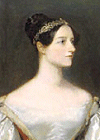Ada Byron, Lady Lovelace
December 10, 1815 - November 27, 1852
Contributed by Dr. Betty Toole
Ada Byron, Lady Lovelace, was one of the most picturesque characters in computer history. Augusta Ada Byron was born December 10, 1815 the daughter of the illustrious poet, Lord Byron. Five weeks after Ada was born Lady Byron asked for a separation from Lord Byron, and was awarded sole custody of Ada who she brought up to be a mathematician and scientist. Lady Byron was terrified that Ada might end up being a poet like her father. Despite Lady Byron's programming Ada did not sublimate her poetical inclinations. She hoped to be "an analyst and a metaphysician". In her 30's she wrote her mother, if you can't give me poetry, can't you give me "poetical science?" Her understanding of mathematics was laced with imagination, and described in metaphors.
At the age of 17 Ada was introduced to Mary Somerville, a remarkable woman who translated LaPlace's works into English, and whose texts were used at Cambridge. Though Mrs. Somerville encouraged Ada in her mathematical studies, she also attempted to put mathematics and technology into an appropriate human context. It was at a dinner party at Mrs. Somerville's that Ada heard in November, 1834, Babbage's ideas for a new calculating engine, the Analytical Engine. He conjectured: what if a calculating engine could not only foresee but could act on that foresight. Ada was touched by the "universality of his ideas". Hardly anyone else was.
Babbage worked on plans for this new engine and reported on the developments at a seminar in Turin, Italy in the autumn of 1841. An Italian, Menabrea, wrote a summary of what Babbage described and published an article in French about the development. Ada, in 1843, married to the Earl of Lovelace and the mother of three children under the age of eight, translated Menabrea's article. When she showed Babbage her translation he suggested that she add her own notes, which turned out to be three times the length of the original article. Letters between Babbage and Ada flew back and forth filled with fact and fantasy. In her article, published in 1843, Lady Lovelace's prescient comments included her predictions that such a machine might be used to compose complex music, to produce graphics, and would be used for both practical and scientific use. She was correct.
When inspired Ada could be very focused and a mathematical taskmaster. Ada suggested to Babbage writing a plan for how the engine might calculate Bernoulli numbers. This plan, is now regarded as the first "computer program." A software language developed by the U.S. Department of Defense was named "Ada" in her honor in 1979.
After she wrote the description of Babbage's Analytical Engine her life was plagued with illnesses, and her social life, in addition to Charles Babbage, included Sir David Brewster (the originator of the kaleidoscope), Charles Wheatstone, Charles Dickens and Michael Faraday. Her interests ranged from music to horses to calculating machines. She has been used as a character in Gibson and Sterling's "The Difference Engine", shown writing letters to Babbage in the series "The Machine that Changed the World" and I have gathered her letters and writings in Ada, The Enchantress of Numbers: A Selection from the Letters of Lord Byron's Daughter and Her Description of the First Computer. Though her life was short (like her father, she died at 36), Ada anticipated by more than a century most of what we think is brand-new computing.
For more information on Ada Byron, refer to Ada, The Enchantress of Numbers, written by Betty Alexandra Toole, Ed.D. and published by Strawberry Press. Now available in a revised paperback edition.
Other resources about Ada Byron
- Rice, Adrian. "An Enchantress of Number? Reassessing the Mathematical Reputation of Ada Lovelace", Notices of the American Mathematical Society, Vol. 71, No. 3 (March 2024), 374-386
- Christopher Hollings, Ursula Martin, and Adrian Rice. ""The early mathematical education of Ada Lovelace", BSHM Bulletin Journal of the British Society for the History of Mathematics 32(3) (June 2017):1-14, DOI: 10.1080/17498430.2017.1325297
- Christopher Hollings, Ursula Martin, and Adrian Rice. "The Lovelace-De Morgan mathematical correspondence: a critical re-appraisal," Historia Mathematica, Vol. 44 (August 2017), no. 3, 202--231.
- Christopher Hollings, Ursula Martin, and Adrian Rice. "Ada Lovelace, the Making of a Computer Scientist, University of Chicago Press, 2018.
- Ada Lovelace's Mathematical Papers, from the Clay Mathematical Institute.
- The Scientific Life of Ada Lovelace, YouTube video of a talk given by Professor Ursula Martin at Gresham College in 2015.
- Calculating Ada: The Countess Of Computing, BBC documentary
- A Selection and Adaptation From Ada's Notes
- The Analytical Engine at http://www.fourmilab.to/babbage/contents.html. Read historical documents related to the Engine, including Ada Lovelace's translation and commentary of "Sketch of the Analytical Engine" by L.F. Menabrea.
- Ada & the Analytical Engine by Elisabeth Freeman, Educom Review, Volume 31, Number 2, March/April 1996.
- Martin, Ursula. "Ada Lovelace, mathematician", Math. Today (Southend-on-Sea) 51 (2015), no. 6, 254.
- Baum, Joan. The Calculating Passion of Ada Byron, Archon Books, 1986.
- Angluin, Dana. "Lady Lovelace and the Analytical Engine," AWM Newsletter, Vol. 6, No. 1 (January 1976), 5-10, and Vol. 6, No. 2 (February 1976), 6-8. [Reprinted in Complexities: Women in Mathematics, Bettye Anne Case and Anne Leggett, Editors, Princeton University Press (2005), 60-67.]
- Perl, Teri. "Ada Augusta Byron Lovelace," in Notable Women in Mathematics: A Biographical Dictionary, Charlene Morrow and Teri Perl, Editors, Greenwood Press (1998), 128-133.
- Deley, Ortis. YouTube Video about Ada Lovelace from BCS, The Chartered Institute for IT.
- Fry, Hannah. "Not your typical role model: Ada Lovelace the 19th century programmer," BBC Four website.
- Ada Lovelace, Wikipedia Entry
- Biography at the MacTutor History of Mathematics Archive
Photo credit: The Ada Picture Gallary

